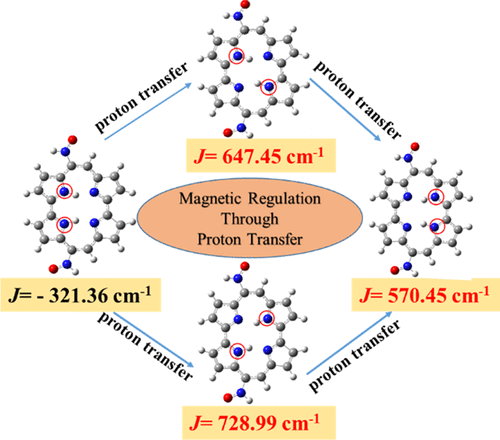当前位置:
X-MOL 学术
›
J. Phys. Chem. C
›
论文详情
Our official English website, www.x-mol.net, welcomes your
feedback! (Note: you will need to create a separate account there.)
Proton-Transfer-Regulated Magnetic Spin Couplings in Nitroxide-Functionalized Porphycene Diradicaloids
The Journal of Physical Chemistry C ( IF 3.3 ) Pub Date : 2019-04-22 , DOI: 10.1021/acs.jpcc.9b01221
Qi Wang 1 , Xinyu Song 1 , Ping Li 2 , Yuxiang Bu 1, 2
The Journal of Physical Chemistry C ( IF 3.3 ) Pub Date : 2019-04-22 , DOI: 10.1021/acs.jpcc.9b01221
Qi Wang 1 , Xinyu Song 1 , Ping Li 2 , Yuxiang Bu 1, 2
Affiliation

|
Porphycene has found many promising applications due to its unique structure including flexible proton-transfer tautomerization, while its large conjugated configuration can also assure it as a coupler for the diradical systems. In this work, we theoretically design the porphycene diradicals using porphycene as the coupler and nitroxide radical groups as spin sources and explore their proton-transfer-regulated magnetic spin coupling characteristics at the density functional theory level. Structurally, introduction of nitroxide radical groups does not change the planarity of porphycene, which is beneficial to the spin coupling between the two spin sources. The calculated results verify that the porphycene coupler can support quite large spin coupling interactions in a large range (J being from −1933 to 729 cm–1) and proton transfers in the porphycene couplers can not only regulate the spin coupling degrees (e.g., −1037 cm–1 vs −1832 cm–1) but also realize the ferromagnetic ↔ antiferromagnetic coupling interconversion (e.g., 647 cm–1 vs −320 cm–1). We also find that the linking position and orientation of the nitroxide radical groups can noticeably modify the magnetic spin coupling properties of the porphycene diradicals. Different porphycene diradicals featuring different nitroxide-linking modes possess different spin coupling pathways and thus different spin coupling characteristics. Besides, spin delocalization and SOMO–SOMO energy splittings of the triplet state are used to analyze the magnetic spin coupling differences among these diradicals. It should be noted that compared with the parent porphycene, nitroxide-diradicalized porphycene derivatives have considerably lower intramolecular proton-transfer barriers in the core regions, favoring the regulation. This work provides useful information for a rational design of the biomotif-based magnetic molecular devices.
中文翻译:

一氧化氮官能化的卟啉双自由基中质子转移调节的磁自旋耦合。
卟啉由于其独特的结构(包括灵活的质子转移互变异构)而发现了许多有前途的应用,而其大的共轭构型也可确保将其用作双自由基体系的成色剂。在这项工作中,我们从理论上设计了以卟啉为偶合剂和氧化氮自由基基团为自旋源的卟啉双基,并在密度泛函理论水平上探索了它们的质子转移调节磁自旋耦合特性。从结构上讲,氮氧化物自由基基团的引入不会改变卟啉的平面度,这有利于两个自旋源之间的自旋耦合。计算结果验证了卟啉偶联剂可以在较大范围内支持相当大的自旋偶联相互作用(J为-1933至729 cm–1)和二茂金属耦合剂中的质子转移不仅可以调节自旋耦合度(例如,-1037 cm –1对−1832 cm –1),而且还可以实现铁磁↔反铁磁耦合互变(例如,647 cm –1 vs −320厘米–1)。我们还发现,氮氧化物自由基基团的连接位置和取向可以显着改变卟啉双基的磁自旋耦合特性。具有不同氮氧化物连接模式的不同卟啉双基具有不同的自旋耦合途径,因此具有不同的自旋耦合特性。此外,使用三重态的自旋离域和SOMO–SOMO能量分裂来分析这些双自由基之间的磁自旋耦合差异。应该注意的是,与母体卟啉相比,氮氧化物二自由基化的卟啉衍生物在核心区域具有相当低的分子内质子转移势垒,有利于调节。这项工作为基于生物基序的磁性分子设备的合理设计提供了有用的信息。
更新日期:2019-04-22
中文翻译:

一氧化氮官能化的卟啉双自由基中质子转移调节的磁自旋耦合。
卟啉由于其独特的结构(包括灵活的质子转移互变异构)而发现了许多有前途的应用,而其大的共轭构型也可确保将其用作双自由基体系的成色剂。在这项工作中,我们从理论上设计了以卟啉为偶合剂和氧化氮自由基基团为自旋源的卟啉双基,并在密度泛函理论水平上探索了它们的质子转移调节磁自旋耦合特性。从结构上讲,氮氧化物自由基基团的引入不会改变卟啉的平面度,这有利于两个自旋源之间的自旋耦合。计算结果验证了卟啉偶联剂可以在较大范围内支持相当大的自旋偶联相互作用(J为-1933至729 cm–1)和二茂金属耦合剂中的质子转移不仅可以调节自旋耦合度(例如,-1037 cm –1对−1832 cm –1),而且还可以实现铁磁↔反铁磁耦合互变(例如,647 cm –1 vs −320厘米–1)。我们还发现,氮氧化物自由基基团的连接位置和取向可以显着改变卟啉双基的磁自旋耦合特性。具有不同氮氧化物连接模式的不同卟啉双基具有不同的自旋耦合途径,因此具有不同的自旋耦合特性。此外,使用三重态的自旋离域和SOMO–SOMO能量分裂来分析这些双自由基之间的磁自旋耦合差异。应该注意的是,与母体卟啉相比,氮氧化物二自由基化的卟啉衍生物在核心区域具有相当低的分子内质子转移势垒,有利于调节。这项工作为基于生物基序的磁性分子设备的合理设计提供了有用的信息。































 京公网安备 11010802027423号
京公网安备 11010802027423号